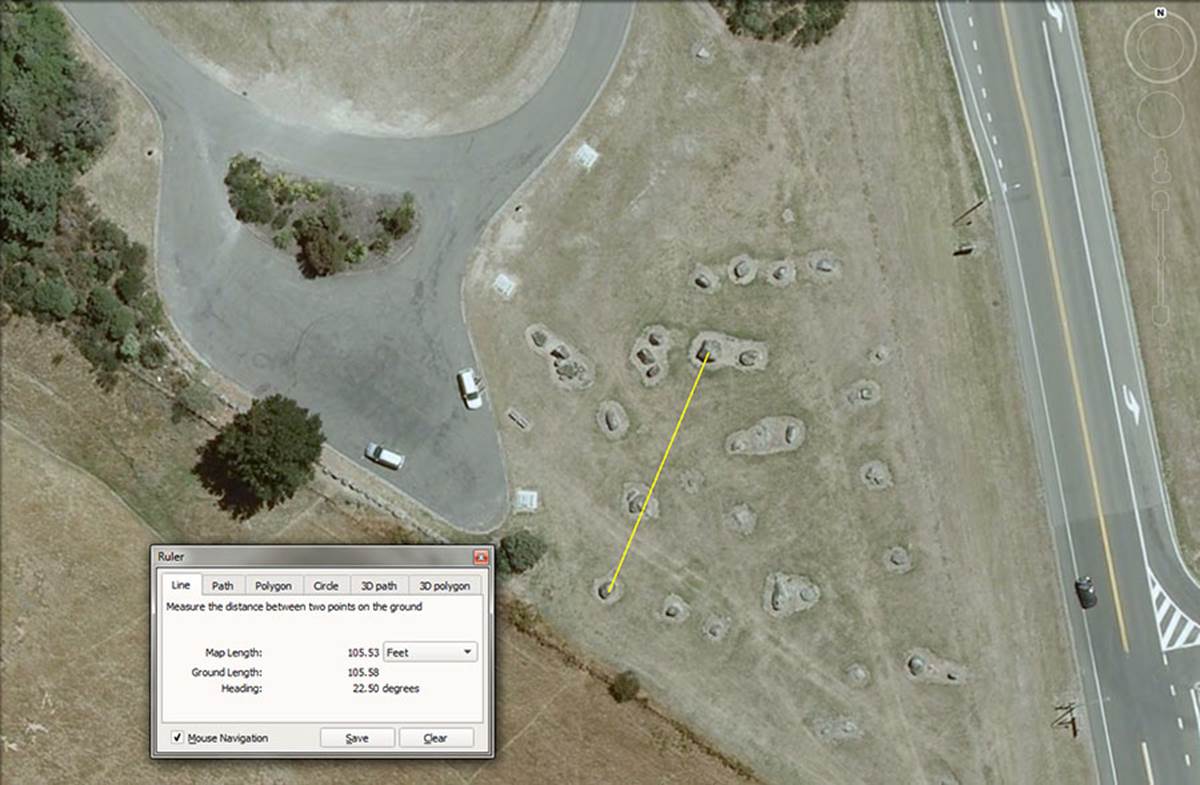
POSITION 5.

This outer-marker sits 105.6-feet from the hubstone at a return angle back to the hubstone of 22.5-degrees.
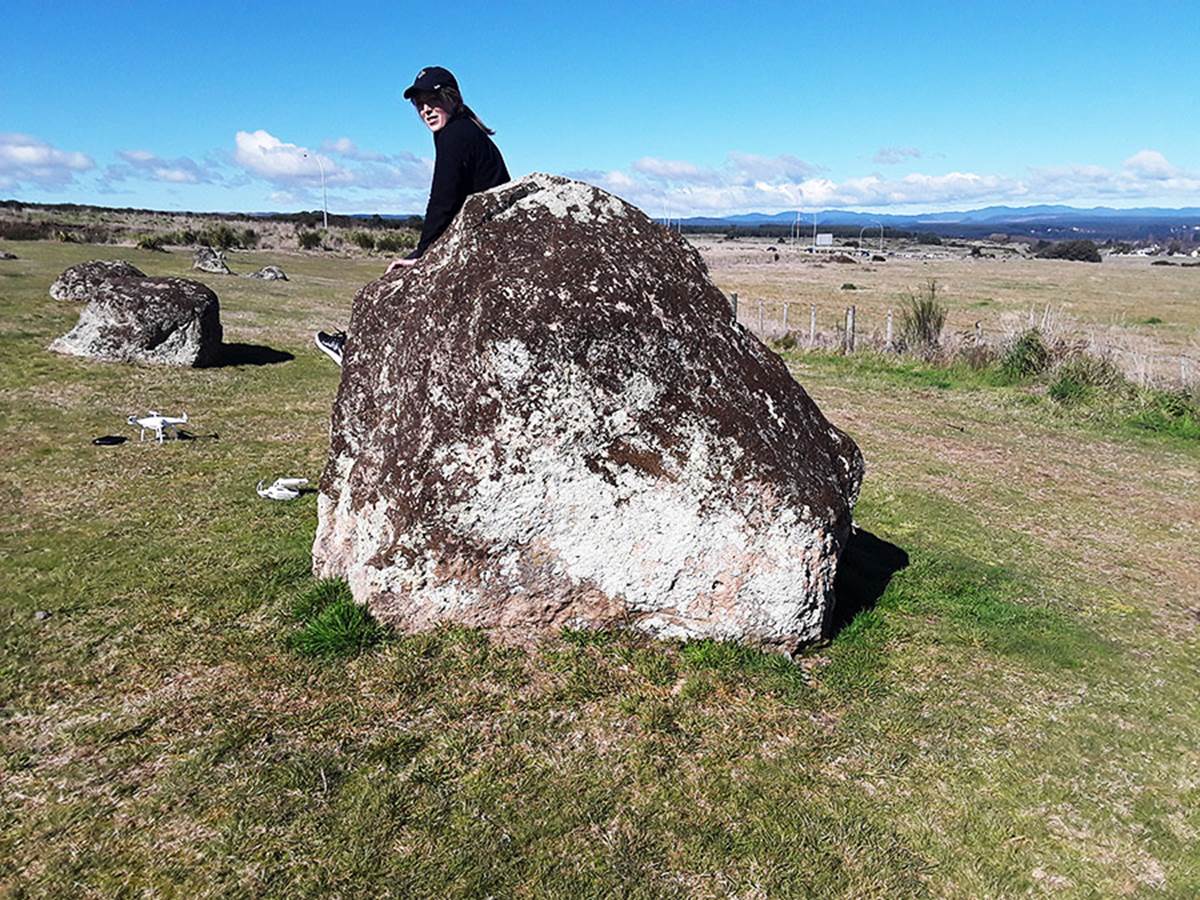
Whereas the previous position (4) gave a tutorial based upon 105-feet and its relationship to navigating by the 5250-feet mile, this position (5) introduces 105.6-feet and navigation by the mile of 5280-feet.
Note: 10500-feet is 2 Greek miles of 5250-feet each, whereas 10560-feet is 2 English miles of 5280-feet each. On megalithic or mound complex sites across the world it’s a general rule of thumb that whenever the mile of 5250-feet is encoded, very close by the mile of 5280-feet will also be encoded simultaneously.
POSITION 6.

The very learned, ancient Masters of the Craft, teaching initiate students on this “micro” site, were able to encode at least 7 highly important distance numbers into this position, as well as 3 of the most significant values that related to the equatorial circumference of the Earth under 3 navigational systems.

The large obelisk and its smaller companion appear to have been tumbled towards the west from their former standing positions. Given their individual girths, they undoubtedly contained a whole raft of numerically close-proximity distance and angle codes.
The smaller of the two complies well to coding a distance of 68.75-feet from the hubstone, with a second reading of 69.12-feet. The angle dissecting the boulder would be 200-degrees, with a return angle of 20-degrees. The return angle could also be read as 20.16-degrees and a tutorial about the merits of 2016 (1/3rd of 1-minute of arc) could also be discussed.
The value 69.12-miles (of 5250-feet) was 1-degree of equatorial arc under the Great Pyramid’s literal geodetic system of navigation, with 1-minute of arc set at 6048-feet. This was the “6&7” system where the distance increments were divisible by either 6 or 7. For example, the 5250-feet mile = 750 X 7 or 875 X 6.
The value 68.75-miles (of 5280-feet) was 1-degree of equatorial arc under the slightly elongated system that set 1-minute of arc at 6050-feet. This was the “11” system, where all distance increments were divisible by “11”. For example, the 5280-feet mile = 480 X 11.
Alternatively, across the wide girth of the big obelisk a much larger selection of distance codes, extractible by a calibrated measuring rope or string, could be identified. These include:
64.8- feet (Precession of the Equinoxes). In the duration of Precession (25920-years), 6480-years would be 1/4th of the cycle.
65.34-feet (The equatorial circumference under the 5280-feet mile system). Under that system, with 6050-feet being 1-minute of arc, the total number of feet circumnavigating the world equated to 130680000-feet or 65340000 X 2.
66-feet (1-chain or 1/80th of the 5280-feet mile … or 1/90th of the 5940-feet Scottish mile).
67.2-feet (navigational coding made up of 1/90th divisions of 1-minute of equatorial arc). 67.2 X 90 = 6048.
68.04-feet (Lunar nutation cycle of 6804-days duration).
Over the girth of the obelisk, 3 close proximity Egyptian Royal Cubits values could be accommodated by way of the degree angle… ranging in a marginal sweep from 206.18 to 206.25 to 207.36 –degrees respectively.
The first of the Egyptian Royal Cubits, here under consideration (and found in the Turin Museum) was 20.61818182-inches. Its exact length is determined by taking the base length of the Great Pyramid and dividing by 440. Therefore, 756-feet (9072-inches) ÷ 440 = 20.61818182-inches.
The Royal Cubit, with its irregular segment divisions, was not used for construction, but only as a mnemonic device for remembering the equatorial size of the Earth. The key was to read the full-length inch value of the cubit as miles of 5280-feet, then multiply the cubit’s length by 1200.
Therefore: 20.61818182-miles X 1200 = 24741.818181818181-miles, which converts to 130636800-feet or 12 X 12 X 12 X 12 X 1.2 Greek miles of 5250-feet each (24883.2 Greek miles) or 6048-feet per minute of arc.
The second Royal Cubit, found by Petrie was 20.625-inches. Its exact length is determined by taking the slightly elongated base length of the Great Pyramid (756.25-feet) and dividing by 440. The sum of 756.25-feet (9075-inches) ÷ 440 = 20.625-inches.
Therefore: 20.625-miles X 1200 = 24750-miles of 5280-feet each. This converts to 130680000-feet or 6050-feet per minute of arc.
The third Royal Cubit was found by measuring the Great Pyramid’s paving slabs as 1.728-feet or 20.736-inches.
Therefore 20.736-miles of 5280-feet each X 1200 = 24883.2-miles or 131383296-feet or 6082.56-feet per minute of arc. The true equatorial circumference (24902-miles) is 131482560-feet or 6087.15-feet per minute of arc, but this value is not fluidly divisible or factorable down into smaller whole numbers and easily calculated fractions for navigational determinations.
POSITION 7.
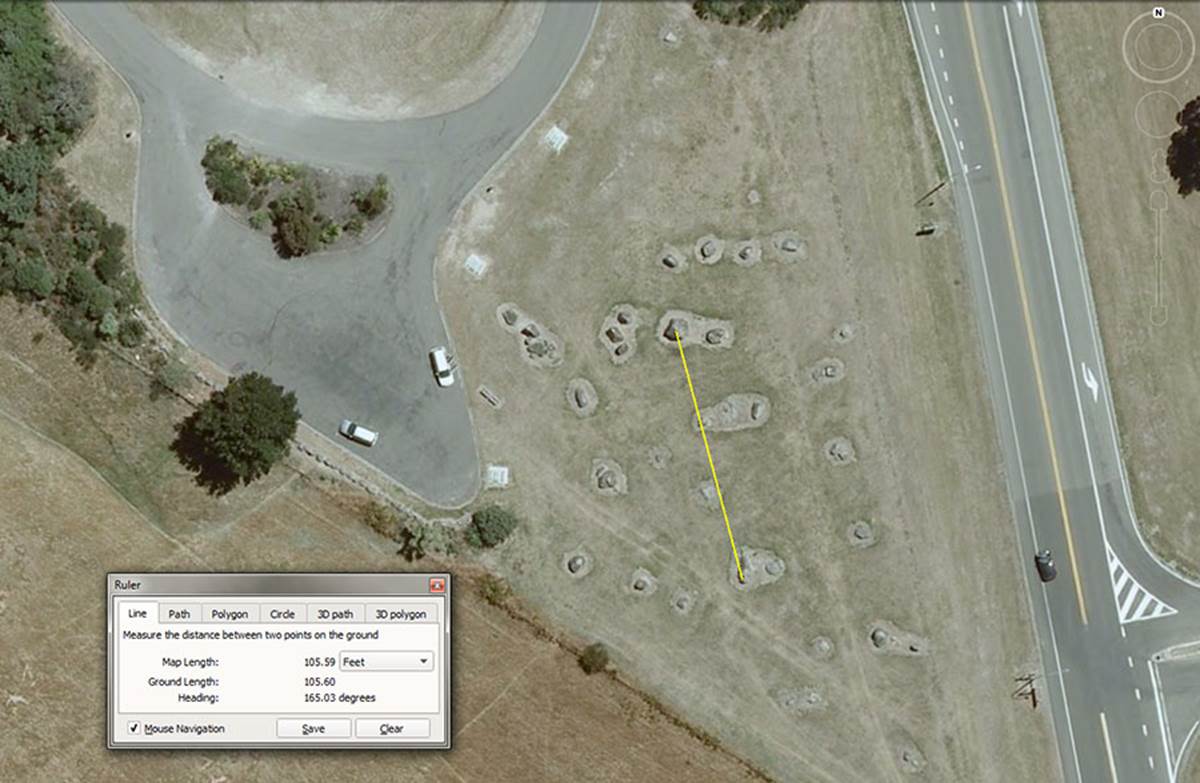
This position is made up of 1 sizable boulder and a hefty obelisk. Over its expanse several coded readings are possible onto the two component stones, including 105.6-feet @ 165-degrees onto the large obelisk (background); also a distance of 101.25-feet or 105-feet, at a return angle of 343.75-degrees more centrally, The foreground boulder complies with a coded distance of 105-feet on an angle of 157.5-degrees.

The two component parts, side-by-side, of position 7.
1. The first reading of 105.6-feet @ 165-degrees relates to navigation under the mile of 5280-feet and league of 16500-feet (3.125-miles).
A reading of 101.25-feet encodes the following progression:
101.25, 202.5, 303.75, 405, 506.25, 607.5, 708.75, 810, 911.25, 1012.5, 1113.75, 1215, … 1620, … 2430, … 2531.25, … 2835, … 3543.75, … etc.
In the lunar-year of 354.375-days, there would be 35 X 10.125-days (243-hours). Also, in the 6804-day duration of the lunar nutation cycle there would be 19.2 lunar years or 672 intervals of 10.125-days.
It must be remembered that without the luxury of perishable books the duration and breakdown of lunar cycles had to be memorised in factorable number strings in order to stay daily abreast of progress within the lunisolar calendar.
In the above string the value 708.75 (in feet) is the design length of the Khafre Pyramid of Egypt and 2835-feet is the distance around the pyramid for all 4 sides.
2. A reading of 105-feet would, of course, be 10 reeds of 10.5-feet each (126-inches or 10 Greek feet).
3. A return angle of 343.75-degrees is navigational coding under the 5280-mile navigational system and a progression derived from this value goes:
343.75, 687.5, 1031.25, 1375, 1718.75, 2062.5, 2406.25, 2750, … 5156.25, … 5500, … 6187.5, … 6875, … 7562.5, … 8250, … 11000, … 16500, … 24750.
In the above line-up, 68.75-miles of 5280-feet would be 1-degree of equatorial arc; 20.625-inches would be a Royal Egyptian cubit used for mnemonic reference to the 24750-mile equatorial circumference; 756.25-feet would be the symbolic length of the Great Pyramid in order to create the “11” navigational system, with a mile of 5280-feet and 6050-feet being 1-minute of equatorial arc; 16500-feet is, of course, 1-English league and 24750-miles is the equatorial circumference by this method of grid-referencing the world for navigation.
4. Moving our attention to the smaller boulder, the length is coded to be 105-feet (100 Greek feet) and the angle is 157.5-degrees.
The sum of 157.5-feet would be 1/4th of a Greek stadia (stadium) of 630-feet.
POSITION 8.
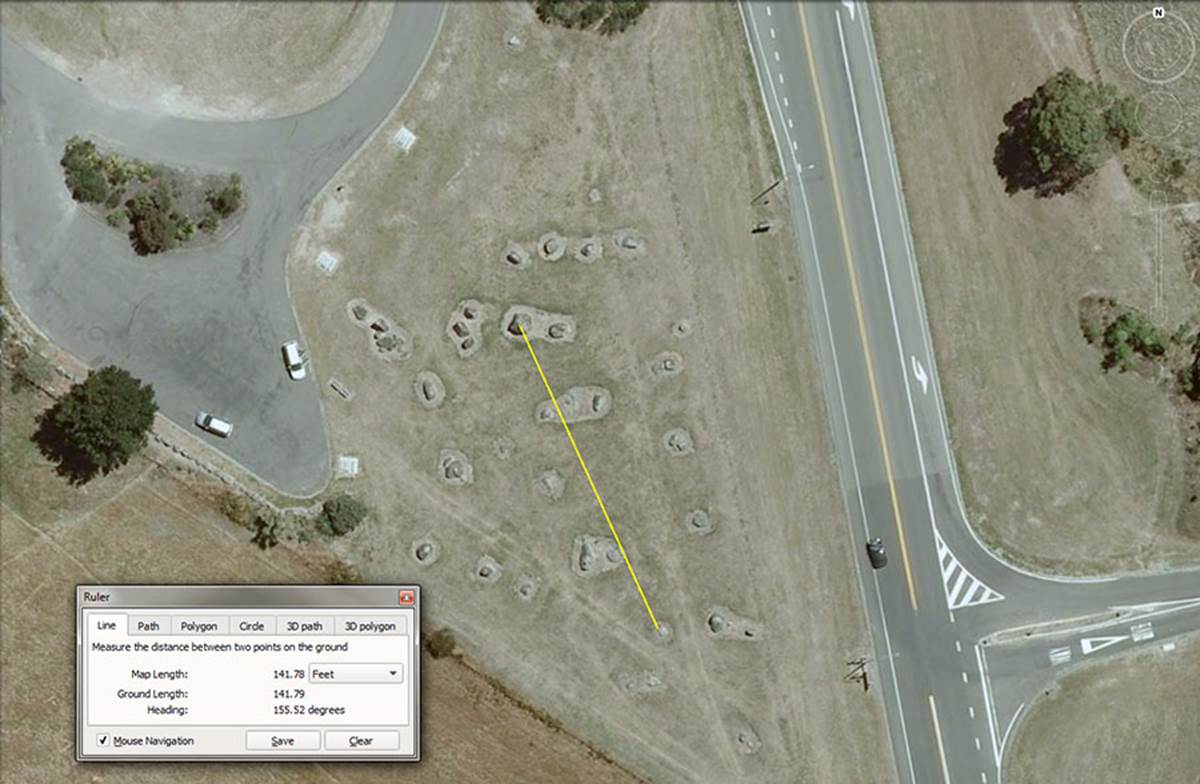
The apparent codes for this small boulder are 141.75-feet from the hubstone @ 155.52-degrees.
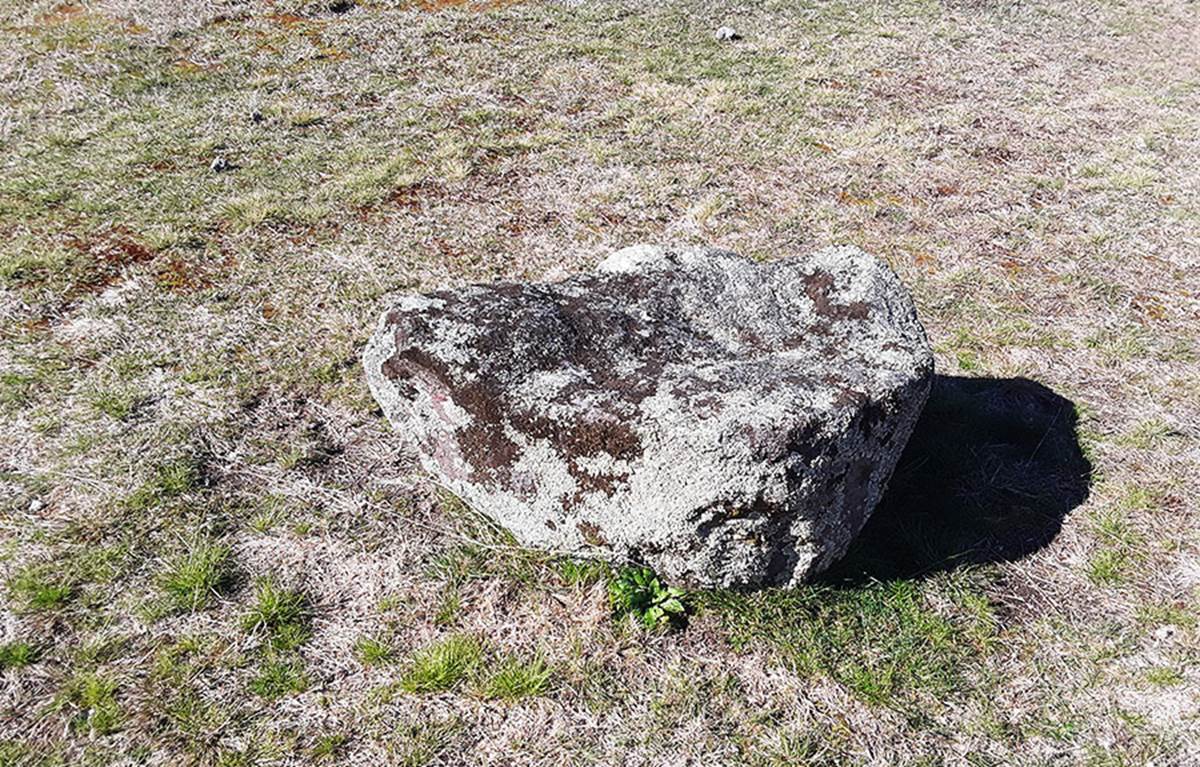
The reasonably small boulder outer-marker.
The distance code of 141.75-feet initiates the following progression:
141.75, 283.5, 425.25, 567, 708.75, 850.5, 992.25, 1134, 1275.75, 1417.5, … 1701, … 2268, … 2551.5, … 2835, … 3402, … 3543.75, … 4536, … 6804, … 9072, … etc.
This progression is both lunar and navigational coding.
1. A period of 141.75-days (3402-hours) would be 1/48th of the 6804-day lunar nutation cycle. In this line-up are the values for side and full circumnavigation lengths of the Khafre Pyramid (Egypt’s pyramid of the moon) …708.75-feet per side and 2835-feet around.
2. The ¼, ½, ¾, and full periods of the 6804-day lunar cycle are present in the progression.
3. Under the lunisolar Sabbatical Calendar system, both the sun and the moon were tracked on a daily basis for 7-solar years and 7.2 lunar years concurrently. Once the solar count was commenced on the summer solstice the druids would wait 6-days (5.25-actual) then begin the lunar count, in conjunction with the mistletoe culling ceremony (cutting sprigs of parasitic mistletoe vines away from an oak tree it had entwined). For this a golden sickle was used (gold representing the sun & the crescent shape representing the waning moon). Below the tree other druids danced around the tree singing “Hey-Derry-Derry-Down”.
Under the Sabbatical Calendar count thus initiated, the solar count of days ran for 2556.75-days (7-solar years) whereas the lunar count ran for 2551.5-days (7.2 lunar years), with both periods ending on the same day.
4. Again we have the lunar year value mentioned, as well as 453.6 (the vertical height of the Great Pyramid to its top floor altar). It was designed as a truncated pyramid without a capstone. There is also 9072, the length of the Great Pyramid in inches or (in feet) 1.5 –minutes of equatorial arc @ 6048-feet per minute. Note: 9072 ÷ 2 = 4536.
5. The degree angle is 155.52 and this value relates to the equatorial circumference of the Earth configured to be 24883.2-miles around.
A progression based upon 155.52 goes:
155.52, 311.04, 466.56, 622.08, 777.6, 933.12, 1088.64, 1244.16, … 1555.2, … 1866.24, … 24883.2.
The sum of 1555.2-miles would be 1/16th of the equatorial circumference or 22.5-degrees of arc; 3110.4-miles would be 45-degrees; 12441.6-miles would be half the circumference.
6. These overall values in the progressions of the ancient mathematicians were encoded into all weights, measures & volumes standards of the cousin civilisations and the value 933120-grains became the Babylonian-Sumerian Talent weight.